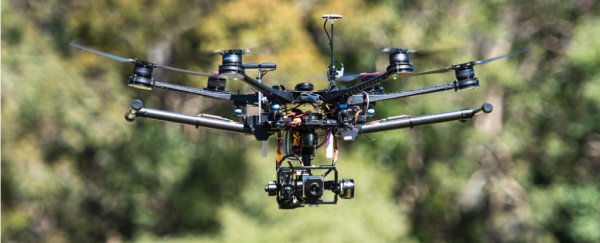Koalas have been doing it tough recently – 70 percent of them are suffering from a chlamydia epidemic, and it's estimated there's only between 43,000 and 100,000 individuals left in the wild.
Now a new project is using unmanned aerial vehicles (UAVs) to track and survey koala populations in South East Queensland and Northern New South Wales, to get a better idea of where these adorable marsupials actually are.
But why do we need drones? Well, koalas are pretty tricky to actually find. A recent study gave us an approximate population size, but there's still a lot of guesswork involved in figuring out exactly how many individuals remain.
"Understanding the abundance of a species in an area is fundamental to the management of that species – and the more regularly and accurately you can monitor the health of the population, the better," said statistical ecologist Grant Hamilton, from the Queensland University of Technology (QUT).
The combined use of drones with thermal imaging, statistical modelling and artificial intelligence is a technique pioneered by researchers at QUT, who developed the algorithms to detect and monitor live koalas.
"Using small drones to take images is becoming more common but we know of no others combining this with cutting-edge analytical technologies that draw meaning from those images," said project leader, Felipe Gonzalez.
The new technology will hopefully also cut fieldwork hours and money. In a test of the system, an area that took humans 2 hours to survey took the drone only 30 minutes.
"We've found thermal imaging can detect even well-camouflaged koalas effectively, and our counting and tracking algorithms can allow us to differentiate the shape of a koala from a possum, bird or other animal," said Gonzalez.
"This project is concentrating on koala populations but the technology can easily be adapted for other species, be they native or pest species, like wild dogs or feral cats."
And they're not just counting the koalas – these machines should also be able to monitor koala movements and population fluctuations, meaning the researchers should have a clearer picture of how to help.
"This combination of technology can provide councils with a wealth of rich data a human cannot, such as exact GPS locations and high-resolution imaging," said Hamilton.
Local governments are also hoping the project can help them co-ordinate conservation efforts – with South-East Queensland and the surrounding area having some of the lowest numbers in the country.
"We know our koalas are on the brink of extinction but we don't know exactly how close," the Mayor of Tweed, Councillor Katie Milne, said.
"Our residents are determined to maintain our coastal koala population. An all-out, full-on, last-ditch effort is needed with the whole community, developers and government if we are to succeed."
The project is expected to wrap up in the next few months, so we'll hopefully be able to see some results then. Good luck, koalas!
Queensland University of Technology is a sponsor of ScienceAlert. Find out more about their research.
